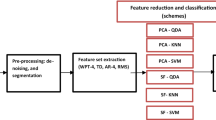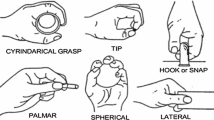Abstract
Surface electromyogram sensors have been widely used to acquire hand gestures signals. Many machine learning and artificial intelligence methods have been presented for automated surface electromyogram signals classification. In this method, a novel surface electromyogram signals recognition method is presented using a novel 1D local descriptor. The proposed descriptor is called as statistical decimal pattern and it is utilized as feature extractor in this study and tunable q-factor wavelet transform is used as pooling in this method. By using tunable q-factor wavelet transform and the proposed statistical decimal pattern, a multileveled learning method is constructed. Ten levels are created by using tunable q-factor wavelet transform. Statistical decimal pattern extracts features from tunable q-factor wavelet transform sub-bands of the raw surface electromyogram signal. Then, the generated features are concatenated, and to select distinctive features, ReliefF and neighborhood component analysis are used together. In the classification phase, k-nearest neighbor classifier with city block distance is chosen. To test performance of the proposed tunable q-factor wavelet transform and the proposed statistical decimal pattern-based surface electromyogram classification method, a freely and publicly published dataset was used. In this dataset, 10 hand gestures were defined. Experimental results clearly shown that the proposed tunable q wavelet transform and statistical decimal pattern-based method achieved 98.0%, 99.79% accuracy rates on two datasets and it outcomes other state-of-the-art methods according to these results.









Similar content being viewed by others
References
Acharya UR, Sudarshan VK, Rong SQ, Tan Z, Lim CM, Koh JE et al (2017) Automated detection of premature delivery using empirical mode and wavelet packet decomposition techniques with uterine electromyogram signals. Comput Biol Med 85:33–42
Akben SB (2017) Low-cost and easy-to-use grasp classification, using a simple 2-channel surface electromyography (sEMG). Biomed Res 28(2):577–582
Akhmadeev K, Rampone E, Yu T, Aoustin Y, Le Carpentier E (2017) A testing system for a real-time gesture classification using surface EMG. IFAC-PapersOnLine 50(1):11498–11503
Alzubi JA, Bharathikannan B, Tanwar S, Manikandan R, Khanna A, Thaventhiran C (2019) Boosted neural network ensemble classification for lung cancer disease diagnosis. Appl Soft Comput 80:579–591
Amamcherla N, Turlapaty A, Gokaraju B (2018) A machine learning system for classification of EMG signals to assist exoskeleton performance. In: IEEE applied ımagery pattern recognition workshop (AIPR). IEEE, pp 1–4
Bhattacharyya A, Pachori R, Upadhyay A, Acharya U (2017) Tunable-Q wavelet transform based multiscale entropy measure for automated classification of epileptic EEG signals. Appl Sci 7(4):385
Cai G, Chen X, He Z (2013) Sparsity-enabled signal decomposition using tunable Q-factor wavelet transform for fault feature extraction of gearbox. Mech Syst Signal Process 41(1–2):34–53
Çerçi Ç, Temeltaş H (2018) Feature extraction of EMG signals, classification with ANN and kNN algorithms. In: 26th Signal processing and communications applications conference (SIU). IEEE, pp 1–4
Denoeux T (2008) A k-nearest neighbor classification rule based on Dempster–Shafer theory. Classic works of the Dempster–Shafer theory of belief functions. Springer, New York, pp 737–760
Faust O, Hagiwara Y, Hong TJ, Lih OS, Acharya UR (2018) Deep learning for healthcare applications based on physiological signals: a review. Comput Methods Programs Biomed 161:1–13
Faust O, Razaghi H, Barika R, Ciaccio EJ, Acharya UR (2019) A review of automated sleep stage scoring based on physiological signals for the new millennia. Comput Methods Programs Biomed 176:81–91
Gokgoz E, Subasi A (2015) Comparison of decision tree algorithms for EMG signal classification using DWT. Biomed Signal Process Control 18:138–144
Harrison KR, Ombuki-Berman BM, Engelbrecht AP (2019) A parameter-free particle swarm optimization algorithm using performance classifiers. Inform Sci 503:381–400
Hu X, Wang Z, Ren X (2005) Classification of surface EMG signal using relative wavelet packet energy. Comput Methods Programs Biomed 79(3):189–195
Iqbal O, Fattah SA, Zahin S (2017) Hand movement recognition based on singular value decomposition of surface EMG signal. In: IEEE Region 10 humanitarian technology conference (R10-HTC). IEEE, pp 837–842
Jıang D, Yu M, Yuanyuan W (2019) Sleep stage classification using covariance features of multi-channel physiological signals on Riemannian manifolds. Comput Methods Programs Biomed 178:19–30
Jin M, Deng W (2018) Predication of different stages of Alzheimer’s disease using neighborhood component analysis and ensemble decision tree. J Neurosci Methods 302:35–41
Jochumsen M, Waris A, Kamavuako EN (2018) The effect of arm position on classification of hand gestures with intramuscular emg. Biomed Signal Process Control 43:1–8
Khushaba RN, Kodagoda S, Takruri M, Dissanayake G (2012) Toward improved control of prosthetic fingers using surface electromyogram (EMG) signals. Expert Syst Appl 39(12):10731–10738
Liu H, Motoda H (2007) Computational methods of feature selection. CRC Press, Boca Raton
Loconsole C, Cascarano GD, Brunetti A, Trotta GF, Losavio G, Bevilacqua V et al (2019) A model-free technique based on computer vision and sEMG for classification in Parkinson’s disease by using computer-assisted handwriting analysis. Pattern Recogn Lett 121:28–36
Malan NS, Sharma S (2019) Feature selection using regularized neighbourhood component analysis to enhance the classification performance of motor imagery signals. Comput Biol Med 107:118–126
Nishad A, Upadhyay A, Pachori RB, Acharya UR (2019) Automated classification of hand movements using tunable-Q wavelet transform based filter-bank with surface electromyogram signals. Future Gen Comput Syst 93:96–110
Noce E, Bellingegni AD, Ciancio AL, Sacchetti R, Davalli A, Guglielmelli E et al (2019) EMG and ENG-envelope pattern recognition for prosthetic hand control. J Neurosci Methods 311:38–46
Nodera H, Osaki Y, Yamazaki H, Mori A, Izumi Y, Kaji R (2019) Deep learning for waveform identification of resting needle electromyography signals. Clin Neurophysiol 130(5):617–623
Patidar S, Pachori RB (2014) Classification of cardiac sound signals using constrained tunable-Q wavelet transform. Expert Syst Appl 41(16):7161–7170
Patidar S, Pachori RB, Acharya UR (2015) Automated diagnosis of coronary artery disease using tunable-Q wavelet transform applied on heart rate signals. Knowl Based Syst 82:1–10
Peterson LE (2009) K-nearest neighbor. Scholarpedia 4(2):1883
Phinyomark A, Phukpattaranont P, Limsakul C (2012) Feature reduction and selection for EMG signal classification. Expert Syst Appl 39(8):7420–7431
Raghu S, Sriraam N (2018) Classification of focal and non-focal EEG signals using neighborhood component analysis and machine learning algorithms. Expert Syst Appl 113:18–32
Reaz MBI, Hussain M, Mohd-Yasin F (2006) Techniques of EMG signal analysis: detection, processing, classification and applications. Biol Proced Online 8(1):11
Robnik-Šikonja M, Kononenko I (2003) Theoretical and empirical analysis of ReliefF and RReliefF. Mach Learn 53(1–2):23–69
Ruangpaisarn Y, Jaiyen S (2015) SEMG signal classification using SMO algorithm and singular value decomposition. In: 7th International conference on ınformation technology and electrical engineering (ICITEE). IEEE, pp 46–50
Ryu J, Kim D-H (2017) Real-time gait subphase detection using an EMG signal graph matching (ESGM) algorithm based on EMG signals. Expert Syst Appl 85:357–365
Sabour S, Frosst N, Hinton GE (2017) Dynamic routing between capsules. In: Proceeding of advances in neural information processing systems (NIPS), pp 3859–3869
Sadikoglu F, Kavalcioglu C, Dagman B (2017) Electromyogram (EMG) signal detection, classification of EMG signals and diagnosis of neuropathy muscle disease. Proc Comput Sci 120:422–429
Sapsanis C, Georgoulas G, Tzes A, Lymberopoulos D (2013) Improving EMG based classification of basic hand movements using EMD. In: 35th Annual international conference of the IEEE engineering in medicine and biology society (EMBC). IEEE, pp 5754–5757
Shashikant R, Chetankumar P (2019) Predictive model of cardiac arrest in smokers using machine learning technique based on heart rate variability parameter. Appl Comput Inf
Sheng X, Lv B, Guo W, Zhu X (2019) Common spatial-spectral analysis of EMG signals for multiday and multiuser myoelectric interface. Biomed Signal Process Control 53:101572
Shi W-T, Lyu Z-J, Tang S-T, Chia T-L, Yang C-Y (2018) A bionic hand controlled by hand gesture recognition based on surface EMG signals: a preliminary study. Biocybern Biomed Eng 38(1):126–135
Song Z, Roussopoulos N (2001) K-nearest neighbor search for moving query point. In: International symposium on spatial and temporal databases. Springer, New York, pp 79–96
Stålberg E, van Dijk H, Falck B, Kimura J, Neuwirth C, Pitt M et al (2019) Standards for quantification of EMG and neurography. Clin Neurophysiol 130:1688–1729
Subasi A (2013) Classification of EMG signals using PSO optimized SVM for diagnosis of neuromuscular disorders. Comput Biol Med 43(5):576–586
Subasi A, Yaman E, Somaily Y, Alynabawi HA, Alobaidi F, Altheibani S (2018) Automated EMG signal classification for diagnosis of neuromuscular disorders using DWT and bagging. Proc Comput Sci 140:230–237
Tsai A-C, Hsieh T-H, Luh J-J, Lin T-T (2014) A comparison of upper-limb motion pattern recognition using EMG signals during dynamic and isometric muscle contractions. Biomed Signal Process Control 11:17–26
Tuncer T, Dogan S, Pławiak P, Acharya UR (2019) Automated arrhythmia detection using novel hexadecimal local pattern and multilevel wavelet transform with ECG signals. Knowl Based Syst 186:104923
Tuncer T, Dogan S, Subasi A (2020) Surface EMG signal classification using ternary pattern and discrete wavelet transform based feature extraction for hand movement recognition. Biomed Signal Process Control 58:101872
Wang H, Chen J, Dong G (2014) Feature extraction of rolling bearing’s early weak fault based on EEMD and tunable Q-factor wavelet transform. Mech Syst Signal Process 48(1–2):103–119
Waris A, Niazi IK, Jamil M, Gilani O, Englehart K, Jensen W et al (2018) The effect of time on EMG classification of hand motions in able-bodied and transradial amputees. J Electromyogr Kinesiol 40:72–80
Yang W, Wang K, Zuo W (2012) Fast neighborhood component analysis. Neurocomputing 83:31–37
Yousefi J, Hamilton-Wright A (2014) Characterizing EMG data using machine-learning tools. Comput Biol Med 51:1–13
Zafra A, Pechenizkiy M, Ventura S (2012) ReliefF-MI: an extension of ReliefF to multiple instance learning. Neurocomputing 75(1):210–218
Author information
Authors and Affiliations
Corresponding author
Ethics declarations
Conflict of interest
There is no “conflict of interest” in the publication of the manuscript “A novel statistical decimal pattern based surface electromyogram signal classification method using tunable q-factor wavelet transform.”
Ethical approval
This article does not contain any studies with human participants or animals performed by any of the authors.
Additional information
Communicated by V. Loia.
Publisher's Note
Springer Nature remains neutral with regard to jurisdictional claims in published maps and institutional affiliations.
Rights and permissions
About this article
Cite this article
Dogan, S., Tuncer, T. A novel statistical decimal pattern-based surface electromyogram signal classification method using tunable q-factor wavelet transform. Soft Comput 25, 1085–1098 (2021). https://doi.org/10.1007/s00500-020-05205-y
Published:
Issue Date:
DOI: https://doi.org/10.1007/s00500-020-05205-y




